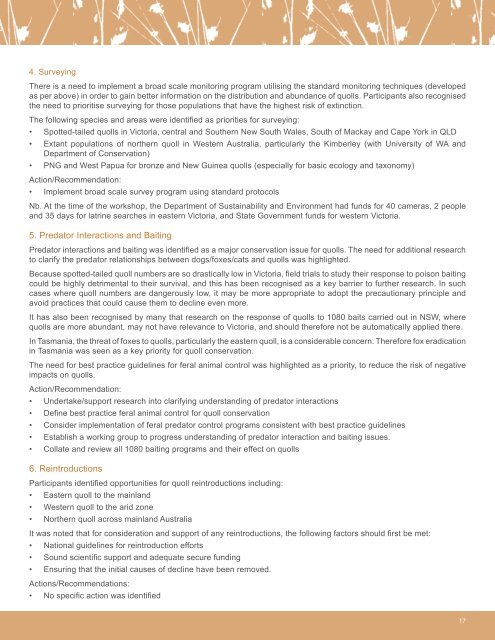Proceedings of the WWF-Australia Quoll Workshop
Proceedings of the WWF-Australia Quoll Workshop
Proceedings of the WWF-Australia Quoll Workshop
You also want an ePaper? Increase the reach of your titles
YUMPU automatically turns print PDFs into web optimized ePapers that Google loves.
4. SurveyingThere is a need to implement a broad scale monitoring program utilising <strong>the</strong> standard monitoring techniques (developedas per above) in order to gain better information on <strong>the</strong> distribution and abundance <strong>of</strong> quolls. Participants also recognised<strong>the</strong> need to prioritise surveying for those populations that have <strong>the</strong> highest risk <strong>of</strong> extinction.The following species and areas were identified as priorities for surveying:• Spotted-tailed quolls in Victoria, central and Sou<strong>the</strong>rn New South Wales, South <strong>of</strong> Mackay and Cape York in QLD• Extant populations <strong>of</strong> nor<strong>the</strong>rn quoll in Western <strong>Australia</strong>, particularly <strong>the</strong> Kimberley (with University <strong>of</strong> WA andDepartment <strong>of</strong> Conservation)• PNG and West Papua for bronze and New Guinea quolls (especially for basic ecology and taxonomy)Action/Recommendation:• Implement broad scale survey program using standard protocolsNb. At <strong>the</strong> time <strong>of</strong> <strong>the</strong> workshop, <strong>the</strong> Department <strong>of</strong> Sustainability and Environment had funds for 40 cameras, 2 peopleand 35 days for latrine searches in eastern Victoria, and State Government funds for western Victoria.5. Predator Interactions and BaitingPredator interactions and baiting was identified as a major conservation issue for quolls. The need for additional researchto clarify <strong>the</strong> predator relationships between dogs/foxes/cats and quolls was highlighted.Because spotted-tailed quoll numbers are so drastically low in Victoria, field trials to study <strong>the</strong>ir response to poison baitingcould be highly detrimental to <strong>the</strong>ir survival, and this has been recognised as a key barrier to fur<strong>the</strong>r research. In suchcases where quoll numbers are dangerously low, it may be more appropriate to adopt <strong>the</strong> precautionary principle andavoid practices that could cause <strong>the</strong>m to decline even more.It has also been recognised by many that research on <strong>the</strong> response <strong>of</strong> quolls to 1080 baits carried out in NSW, wherequolls are more abundant, may not have relevance to Victoria, and should <strong>the</strong>refore not be automatically applied <strong>the</strong>re.In Tasmania, <strong>the</strong> threat <strong>of</strong> foxes to quolls, particularly <strong>the</strong> eastern quoll, is a considerable concern. Therefore fox eradicationin Tasmania was seen as a key priority for quoll conservation.The need for best practice guidelines for feral animal control was highlighted as a priority, to reduce <strong>the</strong> risk <strong>of</strong> negativeimpacts on quolls.Action/Recommendation:• Undertake/support research into clarifying understanding <strong>of</strong> predator interactions• Define best practice feral animal control for quoll conservation• Consider implementation <strong>of</strong> feral predator control programs consistent with best practice guidelines• Establish a working group to progress understanding <strong>of</strong> predator interaction and baiting issues.• Collate and review all 1080 baiting programs and <strong>the</strong>ir effect on quolls6. ReintroductionsParticipants identified opportunities for quoll reintroductions including:• Eastern quoll to <strong>the</strong> mainland• Western quoll to <strong>the</strong> arid zone• Nor<strong>the</strong>rn quoll across mainland <strong>Australia</strong>It was noted that for consideration and support <strong>of</strong> any reintroductions, <strong>the</strong> following factors should first be met:• National guidelines for reintroduction efforts• Sound scientific support and adequate secure funding• Ensuring that <strong>the</strong> initial causes <strong>of</strong> decline have been removed.Actions/Recommendations:• No specific action was identified17
















